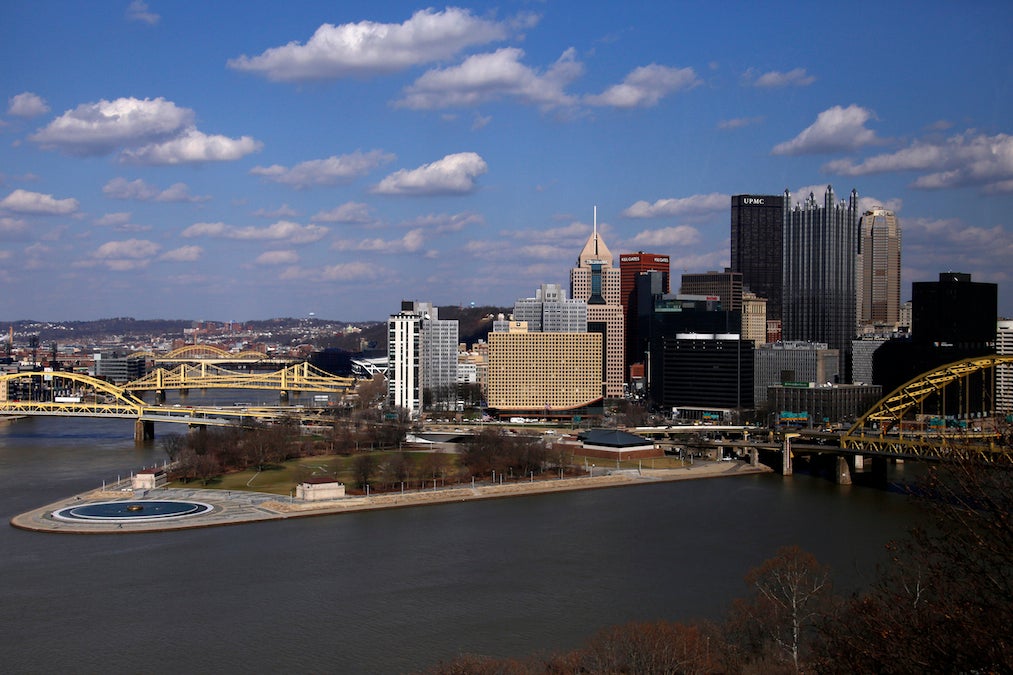Bruce Katz on sustainable development in cities, Pittsburgh’s future, and changing systems
Listen
The skyline of downtown Pittsburgh at the confluence of the Allegheny, Monongahela, and Ohio Rivers. (AP Photo/Gene J. Puskar)
Pittsburgh wants to direct its recent resurgence in a sustainable way, to be a model for urban development around the world.
Pittsburgh recently hosted a gathering of urban planners and designers, government and non-profit leaders, and researchers focused on sustainable urban development from around the world. The invitation-only meeting—called p4 Pittsburgh—ought to explore models for smart growth and to show off where Pittsburgh is headed. At the heart of the initiative are several land development projects totaling about 500 acres throughout the city’s core.
Keystone Crossroads stopped by and caught up with Bruce Katz, Vice President of the Brookings Institution, to talk about opportunities in Pittsburgh and what sustainable development means. Katz is the founding director of the Metropolitan Policy Program; his research focuses on urban issues.
Can you start off by explaining what p4 means to you?
P4 is an initiative that really has been started by [Pittsburgh] Mayor [Bill] Peduto and the Heinz Endowments, and it’s about people, planet, place and performance. It’s trying to really create a new model of urban development for the 21st Century so that you can grow a very strong economy, good jobs, quality jobs, but it’s sustainable, as well. I think increasingly, because of urbanization around the world, cities that are able to adopt this model can prosper and thrive.
A city like Pittsburgh is an older city, there’s a lot of infrastructure already in place, much of it aging. It’s also a city with a really established identity. What kinds of challenges, and opportunity, does that present when thinking about sustainable development and planning for the future?
I actually look at the opportunity side here, because you’re almost a city built for the 21st Century. Because your innovative institutional assets—Carnegie Mellon, University of Pittsburgh, the downtown, UPMC—they’re highly concentrated in the downtown and the Oakland neighborhood. So you have a level of proximity and density, incredible amenities, incredible authenticity. This is what the innovation economy wants today. They actually want to build places like Pittsburgh. So if you could supercharge your innovation economy, you’re going to create a lot of jobs here, and if you could innovate on some of the tough challenges facing the world from a sustainability perspective, you’re going to be one of the leading competitive cities in the world.
So, the challenges, yes, old city: you’ve got to retrofit infrastructure, you’ve got to upskill your young adults for this new technologically sophisticated economy. But you’ve got opportunities and assets that frankly very few places in the U.S. or the world have.
What role do you think waterfronts play?
Waterfronts are incredible amenities for cities. Most cities, particularly in the United States and Europe, were developed along rivers or lakes. But during the Industrial Age, we essentially just polluted them. Now they’ve become areas for residential, for commercial, for office, for retail, and for innovation. This is where the innovative economy wants to be, they want to be in quality places, near advanced research institutions that can draw from a talented workforce and can draw from strong political and business leadership. I mean most cities would die for what you have here in terms of rivers coming together, incredible landscape, beautiful place. I mean, this is one of the most beautiful cities in the United States and the world. Well, the innovative economy is already coming here, it’s going to grow as you move forward.
Much of the p4 plan kind of focuses on specific land development projects. Is there a need to think about systems as well?
Well, I think the way to do smart, sustainable development will require a change in systems. In some ways individual transactions, individual developments, require/demand system change. If you start with system change as your first order of business, you can wallow around a lot, you’ll never get anything done. If you actually start with a particular site and say we’ve got to build for a very different century, well, oh my, that’s going to change land use and zoning and building codes and street grid and so forth and so on, then you get the systems change. It’s a very smart realpolitik to systems change.
So basically you get at the systems through more physical projects, you’re saying.
Fundamentally, system change generally happens whether it’s in education, whether it’s in real estate development, through individual transactions, through new models that are being created.
Pittsburgh is surrounded by older industrial suburbs. In many of them the industry has left or has been diminished significantly. And many of these suburbs or exurbs haven’t seen the same kind of resurgence that the city has. So I’m wondering with something like p4, is it a regional approach, is it more focused on the city? What can the suburbs expect or what should they be doing to get in on this sort of resurgence?
The stronger the city is, the stronger the suburbs are going to be. It’s almost the reverse of how the United States has worked in the past, because we’ve tended to sprawl and decentralize a lot, so we tended to have strong suburbs and weak cities. I think in this century what we’re beginning to see is a resurgence of the cores of our cities, particularly around our advanced research institutions and our medical campuses. And then the suburbs can play in that because there’s going to be a lot of production activity that comes off of this, where we’re reshoring industry in the United States. So when you charge up your innovation economy, you’re going to begin to produce things and your suburbs have great sites for this. This is in fact what was their purpose going back 100 or more years. So I think this is very much a regional approach. I think the city here and the county seem to work very very well together. That’s highly unusual in the United States. So, Pittsburgh and Allegheny County could really be inventing a new model of smart growth, essentially.
In Pittsburgh, there are many acknowledged inequities and also it’s an older city in terms of the age of the population, and the county itself, as well. How do we take care of those people while looking ahead and providing for the people we’re trying to attract to move here?
Well I think this is why the people part of p4 is so critical. Because when you have one innovative job, it creates five other jobs, jobs that support those innovative firms, but then jobs in retail and housing and so forth. The key here is to basically equip workers, whether they’re young adults or whether they’re older workers, with the skills they need to participate in this economy. And so I actually think that a stronger innovative economy is the way to lift all boats, and bring more people along for the ride. But you’ve got to be incredibly focused on your schools, and you’ve got to be intensely focused on skills that relate to the industries and clusters you have. We used to call this shop, or vocational education, apprenticeships, so we’ve got to bring all that back and have nonprofits and our public schools deliver it. But this is a win-win if you can marry up the innovative economy with the potential of people to participate in it.
WHYY is your source for fact-based, in-depth journalism and information. As a nonprofit organization, we rely on financial support from readers like you. Please give today.


